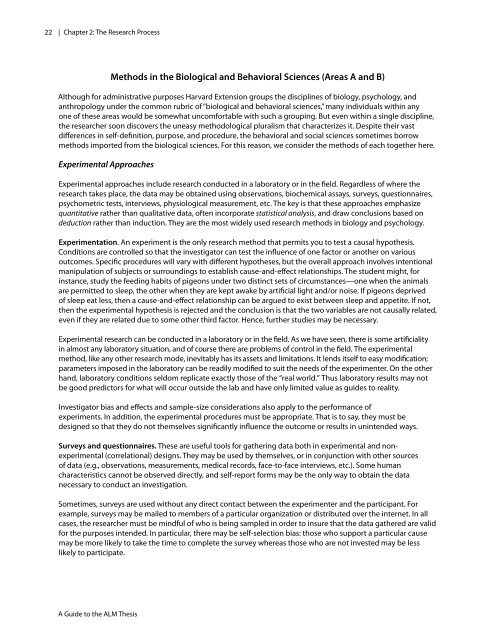A Guide to the ALM Thesis - iSites - Harvard University
A Guide to the ALM Thesis - iSites - Harvard University
A Guide to the ALM Thesis - iSites - Harvard University
Create successful ePaper yourself
Turn your PDF publications into a flip-book with our unique Google optimized e-Paper software.
22<br />
| Chapter 2: The Research Process<br />
Methods in <strong>the</strong> Biological and Behavioral Sciences (Areas A and B)<br />
Although for administrative purposes <strong>Harvard</strong> Extension groups <strong>the</strong> disciplines of biology, psychology, and<br />
anthropology under <strong>the</strong> common rubric of “biological and behavioral sciences,” many individuals within any<br />
one of <strong>the</strong>se areas would be somewhat uncomfortable with such a grouping. But even within a single discipline,<br />
<strong>the</strong> researcher soon discovers <strong>the</strong> uneasy methodological pluralism that characterizes it. Despite <strong>the</strong>ir vast<br />
differences in self-definition, purpose, and procedure, <strong>the</strong> behavioral and social sciences sometimes borrow<br />
methods imported from <strong>the</strong> biological sciences. For this reason, we consider <strong>the</strong> methods of each <strong>to</strong>ge<strong>the</strong>r here.<br />
Experimental Approaches<br />
Experimental approaches include research conducted in a labora<strong>to</strong>ry or in <strong>the</strong> field. Regardless of where <strong>the</strong><br />
research takes place, <strong>the</strong> data may be obtained using observations, biochemical assays, surveys, questionnaires,<br />
psychometric tests, interviews, physiological measurement, etc. The key is that <strong>the</strong>se approaches emphasize<br />
quantitative ra<strong>the</strong>r than qualitative data, often incorporate statistical analysis, and draw conclusions based on<br />
deduction ra<strong>the</strong>r than induction. They are <strong>the</strong> most widely used research methods in biology and psychology.<br />
Experimentation. An experiment is <strong>the</strong> only research method that permits you <strong>to</strong> test a causal hypo<strong>the</strong>sis.<br />
Conditions are controlled so that <strong>the</strong> investiga<strong>to</strong>r can test <strong>the</strong> influence of one fac<strong>to</strong>r or ano<strong>the</strong>r on various<br />
outcomes. Specific procedures will vary with different hypo<strong>the</strong>ses, but <strong>the</strong> overall approach involves intentional<br />
manipulation of subjects or surroundings <strong>to</strong> establish cause-and-effect relationships. The student might, for<br />
instance, study <strong>the</strong> feeding habits of pigeons under two distinct sets of circumstances—one when <strong>the</strong> animals<br />
are permitted <strong>to</strong> sleep, <strong>the</strong> o<strong>the</strong>r when <strong>the</strong>y are kept awake by artificial light and/or noise. If pigeons deprived<br />
of sleep eat less, <strong>the</strong>n a cause-and-effect relationship can be argued <strong>to</strong> exist between sleep and appetite. If not,<br />
<strong>the</strong>n <strong>the</strong> experimental hypo<strong>the</strong>sis is rejected and <strong>the</strong> conclusion is that <strong>the</strong> two variables are not causally related,<br />
even if <strong>the</strong>y are related due <strong>to</strong> some o<strong>the</strong>r third fac<strong>to</strong>r. Hence, fur<strong>the</strong>r studies may be necessary.<br />
Experimental research can be conducted in a labora<strong>to</strong>ry or in <strong>the</strong> field. As we have seen, <strong>the</strong>re is some artificiality<br />
in almost any labora<strong>to</strong>ry situation, and of course <strong>the</strong>re are problems of control in <strong>the</strong> field. The experimental<br />
method, like any o<strong>the</strong>r research mode, inevitably has its assets and limitations. It lends itself <strong>to</strong> easy modification;<br />
parameters imposed in <strong>the</strong> labora<strong>to</strong>ry can be readily modified <strong>to</strong> suit <strong>the</strong> needs of <strong>the</strong> experimenter. On <strong>the</strong> o<strong>the</strong>r<br />
hand, labora<strong>to</strong>ry conditions seldom replicate exactly those of <strong>the</strong> “real world.” Thus labora<strong>to</strong>ry results may not<br />
be good predic<strong>to</strong>rs for what will occur outside <strong>the</strong> lab and have only limited value as guides <strong>to</strong> reality.<br />
Investiga<strong>to</strong>r bias and effects and sample-size considerations also apply <strong>to</strong> <strong>the</strong> performance of<br />
experiments. In addition, <strong>the</strong> experimental procedures must be appropriate. That is <strong>to</strong> say, <strong>the</strong>y must be<br />
designed so that <strong>the</strong>y do not <strong>the</strong>mselves significantly influence <strong>the</strong> outcome or results in unintended ways.<br />
Surveys and questionnaires. These are useful <strong>to</strong>ols for ga<strong>the</strong>ring data both in experimental and nonexperimental<br />
(correlational) designs. They may be used by <strong>the</strong>mselves, or in conjunction with o<strong>the</strong>r sources<br />
of data (e.g., observations, measurements, medical records, face-<strong>to</strong>-face interviews, etc.). Some human<br />
characteristics cannot be observed directly, and self-report forms may be <strong>the</strong> only way <strong>to</strong> obtain <strong>the</strong> data<br />
necessary <strong>to</strong> conduct an investigation.<br />
Sometimes, surveys are used without any direct contact between <strong>the</strong> experimenter and <strong>the</strong> participant. For<br />
example, surveys may be mailed <strong>to</strong> members of a particular organization or distributed over <strong>the</strong> internet. In all<br />
cases, <strong>the</strong> researcher must be mindful of who is being sampled in order <strong>to</strong> insure that <strong>the</strong> data ga<strong>the</strong>red are valid<br />
for <strong>the</strong> purposes intended. In particular, <strong>the</strong>re may be self-selection bias: those who support a particular cause<br />
may be more likely <strong>to</strong> take <strong>the</strong> time <strong>to</strong> complete <strong>the</strong> survey whereas those who are not invested may be less<br />
likely <strong>to</strong> participate.<br />
A <strong>Guide</strong> <strong>to</strong> <strong>the</strong> <strong>ALM</strong> <strong>Thesis</strong>

















